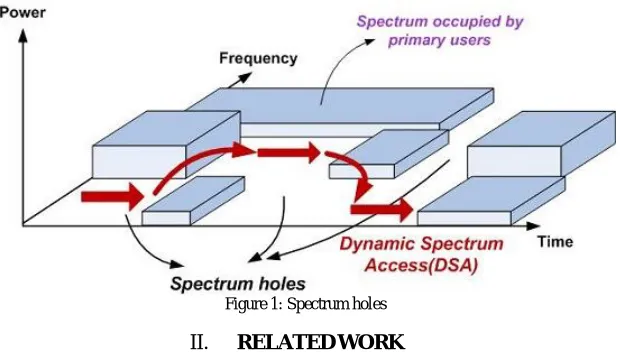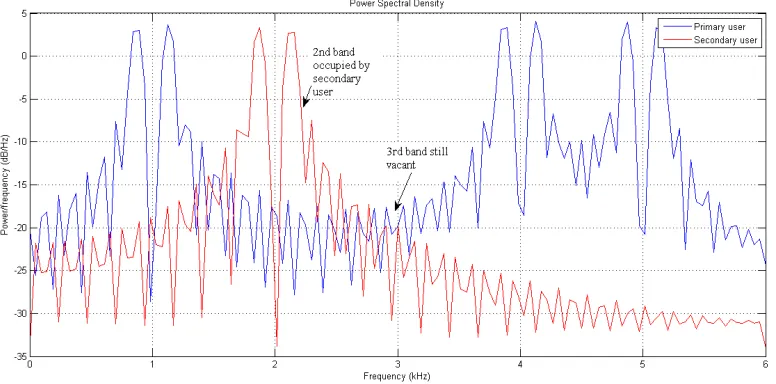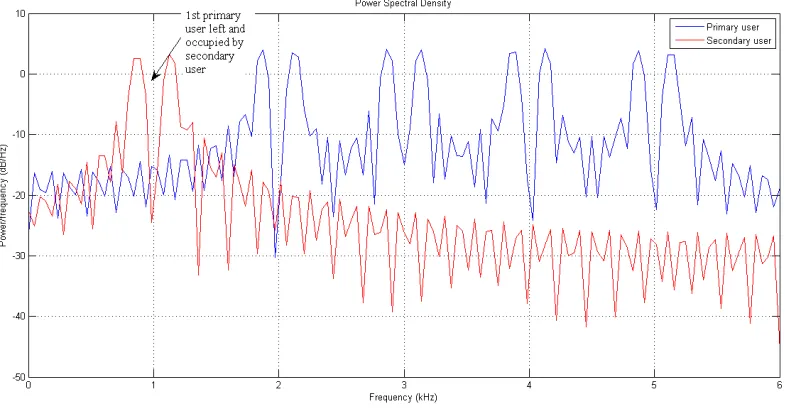ISSN(Online): 2320-9801
ISSN (Print) : 2320-9798
I
nternational
J
ournal of
I
nnovative
R
esearch in
C
omputer
and
C
ommunication
E
ngineering
(An ISO 3297: 2007 Certified Organization)
Vol. 3, Issue 9, September 2015
Spectrum Sensing Techniques and Cognitive
Radio System
Rubina Shaikh
B.E, Dept. of Electronics and Telecommunication, VESIT, Mumbai, Maharashtra, India
ABSTRACT: Federal Communications Commission (FCC) has been examining new ways to manage (Radio frequency) RF resources to withstand the overcrowding of the radio spectrum. Much of the prized spectrum lies idle at any given time and location indicating that spectrum shortage results from the spectrum management policy rather than the physical scarcity of usable frequencies. This underutilization of spectrum has stimulated the concept of dynamic spectrum access and cognitive radio. Cognitive Radio (CR), built on a software radio platform, is a context aware intelligent radio potentially capable of independent recomposition by learning from and adapting to the communication environment. Dynamic spectrum access is indubitably an important application of cognitive radio whose prime notion is to let people use licensed frequencies, while restricting the interference perceived by the primary license holders. CR technology lets unlicensed secondary users to coexist with licensed primary users unlike all other conventional methods which avoid licensed signals. Investigation of the idea of simulating cognitive radio system to reuse locally unused spectrum dynamically for allocation to the unlicensed users is carried out in this paper. Role of transmitter detection spectrum sensing techniques in CR system is also examined.
KEYWORDS: Cognitive radio, spectrum sensing, transmitter detection techniques, energy detection, dynamic spectrum access, threshold, PSD
I. INTRODUCTION
FCC’s spectrum policy task force stated that much of the radio spectrum is underutilized [1]. Out of the total available frequency bands in the spectrum, some of the frequency bands are not utilized, some of the frequency bands are sparsely utilized and few bands are heavily utilized. Each wireless operator is assigned an exclusive license to operate in a certain frequency bands [2] which makes spectrum management inflexible. It is cumbersome to find vacant bands for deploying new services or to enhance existing ones. Improved utilization of the spectrum creates opportunities for dynamic spectrum access. CR technology seems a propitious alternative for making efficient use of available radio spectrum. By analysing, observing and learning, the CR system adapts to the environment conditions and provides the capability to share the wireless channel among licensed and unlicensed users in an opportunistic manner.
The two tiers of users in the cognitive radio model are Primary Users (PU) and Secondary Users (SU). PU are licensed users who have the rights of priority in using certain frequency band for communications whereas SU are unlicensed users or CR users allowed to use the frequency spectra temporarily only if they do not interfere with the PU. If a SU accessing a particular spectrum encounters an incoming PU then it has to vacate that frequency band and look for any spectrum holes (white spaces) in the spectrum as shown in Figure 1 to continue transmission. Thus, the two vital factors for the success of CR are the ability of sensing an idle spectrum and the ability to momentarily utilize a spectrum with minimum interference to primary users [3]. Such a system can be realized using spectrum management functions as described below:
Spectrum sensing: A CR user should continuously monitor the available spectrum bands, capture their information, and then detect spectrum holes.
Spectrum decision: CR users can allocate a channel based on the spectrum availability.
Spectrum sharing: CR network access should be cooperated to prevent multiple users colliding in overlapping portions of the spectrum.
ISSN(Online): 2320-9801
ISSN (Print) : 2320-9798
I
nternational
J
ournal of
I
nnovative
R
esearch in
C
omputer
and
C
ommunication
E
ngineering
(An ISO 3297: 2007 Certified Organization)
Vol. 3, Issue 9, September 2015
Figure 1: Spectrum holes
II. RELATEDWORK
The three fundamental signal processing techniques for spectrum sensing [4] forth put in literature are: Matched filter [5], energy detection [5] and cyclostationary feature detection [6]. Matched filtering is said to be optimal but requires information of licensed signal. When no such data is available, energy detector seems optimal [5]. Most of the literature is based on energy detection algorithm. Cooperative spectrum sensing has been studied in [7] where the final decision is obtained based on cooperative results from different secondary users. Simulation and analysis of CR system is mentioned in literature [8] where the idea of coexistence of unlicensed users is demonstrated in licensed band. This paper extends the idea of simulation of CR system through dynamic spectrum access. Also, analysis and comparison of transmitter detection techniques is done on grounds of literature mentioned above.
III. SPECTRUMSENSINGTECHNIQUES
Spectrum sensing is the ability of cognitive radio to measure, sense and be aware of the parameters related to the radio channel characteristics, availability of spectrum and transmit power. Spectrum sensing enables the CR to detect spectrum holes (unutilized bands of the spectrum). Spectrum sensing techniques can be classified as direct method, also known as frequency domain method, where sensing parameters are evaluated directly from signal and indirect method, known as time domain approach, where the estimation is done using autocorrelation of the signal. Transmitter detection techniques are based on the detection of a weak signal from a primary transmitter and then compared with a predefined theoretical threshold value to govern the presence or absence of licensed users. The basic hypothesis model for transmitter detection can be given as follows:
Where x(t) is the received signal at CR end, s(t) is the transmitted signal of the primary user, n(t) is noise considered due to AWGN (Additive White Gaussian Noise) channel and h is the channel amplitude gain. H0 is null hypothesis i.e.
when there is no primary user and H1 is an alternate hypothesis when primary user is present. Transmitter detection
spectrum sensing techniques in vogue are described below.
A. Matched Filter
Matched filter is said to be the optimal detector for spectrum sensing, if priori knowledge of the primary signal is known as it maximizes the received SNR. Coherency makes detection faster assisting a CR user to occupy a vacant channel quickly without any delay. A notable drawback of this technique is that the radio receiver would need a
0
1
... Primary user absent
... Primary user present
x t n t H
x t h s t n t H
ISSN(Online): 2320-9801
ISSN (Print) : 2320-9798
I
nternational
J
ournal of
I
nnovative
R
esearch in
C
omputer
and
C
ommunication
E
ngineering
(An ISO 3297: 2007 Certified Organization)
Vol. 3, Issue 9, September 2015
dedicated matched filter for every primary user. Block diagram for matched filter detection is shown in Figure 2 as explained in [8].
Figure 2: Block diagram of Matched Filter
B. Energy Detector
If the receiver doesn’t have a priori knowledge of the primary signal, non-coherent detection can be done through energy-detectors [9]. It is implemented by averaging the FFT of the signal over frequency bins and comparing with a threshold to determine the presence of the primary signal. The performance of energy detector is liable to uncertainty as the threshold is ambiguous due to varying noise levels. Also, energy detectors can give erroneous results by in band interference as they cannot distinguish signal types especially at low SNR [10]. Block diagram for Energy detector is shown in Figure 3 as described in [8].
Figure 3: Block diagram of Energy Detector
C. Cyclostationary Feature Detector
In general, modulated signals are characterized by cyclostationarity i.e. their statistical parameters vary periodically in time unlike stationary noise. This feature can be detected by analyzing a spectral correlation function [11]. The prime vantage of this method is its robustness to uncertainty in noise power and channel fluctuations. On the bleak side, it is computationally complex and requires significantly long observation times. Block diagram for this method is shown in Figure 4 as explained in [8].
Figure 4: Block diagram of Cyclostationary Feature Detector
Selection of spectrum sensing techniques is done taking into consideration trade-off between the complexity and the effectiveness of spectrum sensing algorithms. In practice, an amalgam of different techniques can be used to cater different radio scenarios. For instance, energy detection may be used to perform a quick but coarse scan of a wide range of frequencies and then the spectrum holes can be discovered through more accurate feature detection technique.
All the above mentioned transmitter detection techniques are simulated in a similar radio environment for 100 samples of received signal, compared with a predefined threshold to govern presence or absence of licensed primary users using MATLAB. Following are the metrics on which transmitter detection techniques are analyzed and compared for efficient usage of spectrum [12].
ISSN(Online): 2320-9801
ISSN (Print) : 2320-9798
I
nternational
J
ournal of
I
nnovative
R
esearch in
C
omputer
and
C
ommunication
E
ngineering
(An ISO 3297: 2007 Certified Organization)
Vol. 3, Issue 9, September 2015
longer sensing time whereas cyclostationary feature detection, superior to matched filtering is computationally very complex and takes long observation time for sensing. A random cosine signal is used to mimic the actual radio environment where no prior knowledge about primary user is available.
Table 1: Spectrum sensing time
Detection sensitivity: It is defined as the minimum SNR at which the primary signal may still be accurately detected by the cognitive radio. There is a strong dependency between the detection sensitivity of a cognitive radio and the maximum power it is allowed to transmit in a certain licensed band. Figure 5 shows the detection sensitivity for transmitter detection techniques under different SNR conditions when primary user is absent. Energy detector gives poor result at low SNR conditions. At around -10 dB, all techniques give equal probability of detection for same radio environment. Thus, it is discernible from the figure that cyclostatioary feature detector performs best but again at increased cost and complexity.
Figure 5: Comparison of detection sensitivity for transmitter detection techniques [7]
Ease for implementation: Low cost and implementation simplicity renders energy detector as a favorable candidate for spectrum sensing in cognitive radio networks. Matched filter requires generating carrier at receiver, which increases complexity thereby increasing the cost of CR networks. Cyclostationary feature detection on the other hand gives high sensing accuracy at increased cost and computational complexity.
IV. IMPLEMENTATIONOFCOGNITIVERADIOSYSYTEM
Energy detection spectrum sensing technique based on Neyman-Pearson (NP) lemma model is used for the simulation of CR system since it has moderate computational complexities as compared to other transmitter detection algorithms.The NP lemma criterion increases the probability of detection (Pd) for a given probability of false alarm (Pfa). Pd is the probability of detecting a signal on the considered frequency when it truly is present whereas Pfa is the probability that the test incorrectly decides that the considered frequency is occupied when actually it is not. The detection threshold is set using knowledge of noise power in the band to be sensed.
Primary Signal used
Energy Detection Matched Filter Cyclostationary
ISSN(Online): 2320-9801
ISSN (Print) : 2320-9798
I
nternational
J
ournal of
I
nnovative
R
esearch in
C
omputer
and
C
ommunication
E
ngineering
(An ISO 3297: 2007 Certified Organization)
Vol. 3, Issue 9, September 2015
CR technology ameliorates spectrum utilization by allowing secondary users to borrow or share the spectrum with primary users [13]. Secondary user needs to continuously monitor the presence of primary users as they are utilizing the licensed band and have to depart for the primary users [14]. For simulating CR system, the carrier frequencies are chosen to be 1 KHz, 2 KHz, 3 KHz, 4 KHz, 5 KHz and sampling frequency as 12 KHz for five primary users in licensed band. The power spectral density (PSD) of signal is calculated, compared with the predefined threshold value and then presence or absence of primary user is determined.
The following figures show simulation of the different radio scenarios based on energy detection algorithm. Figure 6 indicates the presence of PU at 1st, 4th and 5th position or band and vacant 2nd and 3rd band.
Figure 6: PSD indicating 1st, 4th and 5th band occupied by primary users, 2nd and 3rd vacant
CR system will look for the first available gap (spectrum hole) and automatically assign it to the secondary user in the spectrum as shown in the Figure 7. The CR system will assign the next spectrum hole or vacant band to incoming SU on request.
ISSN(Online): 2320-9801
ISSN (Print) : 2320-9798
I
nternational
J
ournal of
I
nnovative
R
esearch in
C
omputer
and
C
ommunication
E
ngineering
(An ISO 3297: 2007 Certified Organization)
Vol. 3, Issue 9, September 2015
Meanwhile, if a primary user wants to access the spectrum then CR system senses for any spectrum hole and if present allocates it to primary user as shown in the Figure 8 and if no spectrum hole is available in the band then CR system looks for any secondary unlicensed users in the spectrum, fire that SU and then the vacated band is allocated to requesting primary user as seen in Figure 9.
Figure 8: PSD indicating 1st, 3rd, 4th and 5th band occupied by primary users, 2nd by secondary user
Rotating priority is assigned for secondary users i.e. a SU will replace SU if no spectrum hole is available. If all slots are occupied by PU then CR system will wait for a particular sensing period and again look for any vacant bands or secondary users. For simulation sensing period is taken as 5 sec.
Figure 9: PSD indicating 1st, 2nd, 3rd, 4th and 5th band occupied by primary users
ISSN(Online): 2320-9801
ISSN (Print) : 2320-9798
I
nternational
J
ournal of
I
nnovative
R
esearch in
C
omputer
and
C
ommunication
E
ngineering
(An ISO 3297: 2007 Certified Organization)
Vol. 3, Issue 9, September 2015
Figure 10: PSD indicating 2nd, 3rd, 4th and 5th band occupied by primary users and 1st by secondary user
Figure 11: PSD for a SNR value of -10dB
To delineate actual radio environment, noise is introduced as an AWGN channel resulting in reduction in signal peak amplitudes as seen in Figure 11 which in essence impairs the proper signal reception. Thus, analysis and simulation of dynamic spectrum access for cognitive radio system using energy detection spectrum sensing technique is performed.
V. CONCLUSION AND FUTURE WORK
ISSN(Online): 2320-9801
ISSN (Print) : 2320-9798
I
nternational
J
ournal of
I
nnovative
R
esearch in
C
omputer
and
C
ommunication
E
ngineering
(An ISO 3297: 2007 Certified Organization)
Vol. 3, Issue 9, September 2015
cyclostationary feature detection gives best results but requires long computation time. Performance limitations raised by the detection techniques are discussed, and it is argued that these challenges may be overcome by a proper combination of different techniques to cater different radio scenarios.
Spectrum sensing is a multifaceted problem demanding coordinated efforts of the regulatory and technical sides instead of simply focusing on reliable sensing to meet regulatory requirements. Cooperative sensing is one such example where sensing will be furnished by a number of different radios within a cooperative cognitive radio network. Here, transmission statistics of signals from different radios in the network are received by a central station which concludes their combined decision based on the behavior and capabilities of a cognitive radio network as whole rather than individual users with the help of some fusion rule. Spectrum sensing and higher layer functionalities in cross layer communications is a subsequent keynote which can help in improving quality of service (QoS).
REFERENCES
1. Force, FCC Spectrum Policy Task. "Report of the spectrum efficiency working group, Nov. 2002." URL http://www. fcc. gov/sptf/reports. html. 2. Samuel Cheng, 2012, Foundation of Cognitive Radio Systems,
3. James O’Donnell Neel, 2006, “Analysis and Design of Cognitive Radio Networks and Distributed Radio Resource Management Algorithms,” PhD Dissertation, Virginia Polytechnic Institute and State University, Blacksburg, VA.
4. D. Cabric, S. M. Mishra and R. W. Brodersen, “Implementation issues in spectrum sensing for Cognitive Radios”,in Proc of Asilomar conference onsignals, systems and computers, Nov 2004, Vol 1, pp 772-776.
5. A. Sahai, N. Hoven, S.M. Mishra and R. Tandra, “Fundamental tradeoffs in robust spectrum sensing for opportunistic frequency reuse” in Proc FirstIntl Workshop on Tech. and Policy for Accessing Spectrum, Aug 2006.
6. Y. Zhuan, J. Grosspietsch and G. Memik, “Spectrum Sensing using Cyclostationary Spectrum Density for Cognitive Radios”, IEEE workshop on Signal Processing Systems, Oct 2007, pp 1-6.
7. G. Ganesan and Y. Li, “Cooperative Spectrum Sensing in cognitive radio, Part I: two user networks”, IEEE trans. on Wireless Communication, Vol. 6, June 2007, pp 2204-2213.
8. Ghosh, Goutam, Prasun Das, and Subhajit Chatterjee. "Simulation and Analysis of Cognitive radio System using MATLAB." International Journal of Next-Generation Networks (IJNGN) Vol 6 (2014).
9. H. Urkowitz. Energy detection of unknown deterministic signals. Proceedings of the IEEE, 55(4):523 – 531, 1967.
10. A. Sonnenschein and P. M. Fishman, “Radiometric Detection of Spread-Spectrum Signals in Noise,” IEEETrans. Aerospace Elect. Sys., vol. 28, no. 3, Jul. 1992, pp. 654–60.
11. M. Oner and F. Jondral, “On the Extraction of the Channel Allocation Information in Spectrum Pooling Systems,” IEEEJSAC, vol. 25, no. 3, Apr. 2007, pp. 558–65.
12. Ziafat, Sana, Waleed Ejaz, and H. Jamal.”Spectrum sensing techniques for cognitive radio networks: Performance analysis.”Intelligent Radio for Future Personal Terminals (IMWS-IRFPT),2011 IEEE MTT-S International Microwave Workshop Series on. IEEE, 2011.
13. Natasha Devroye, Patrick Mitran, and Vahid Tarokh. Limits on communications in a cognitive radio channel. Communications Magazine, IEEE, 44(6):44{49, 2006.





